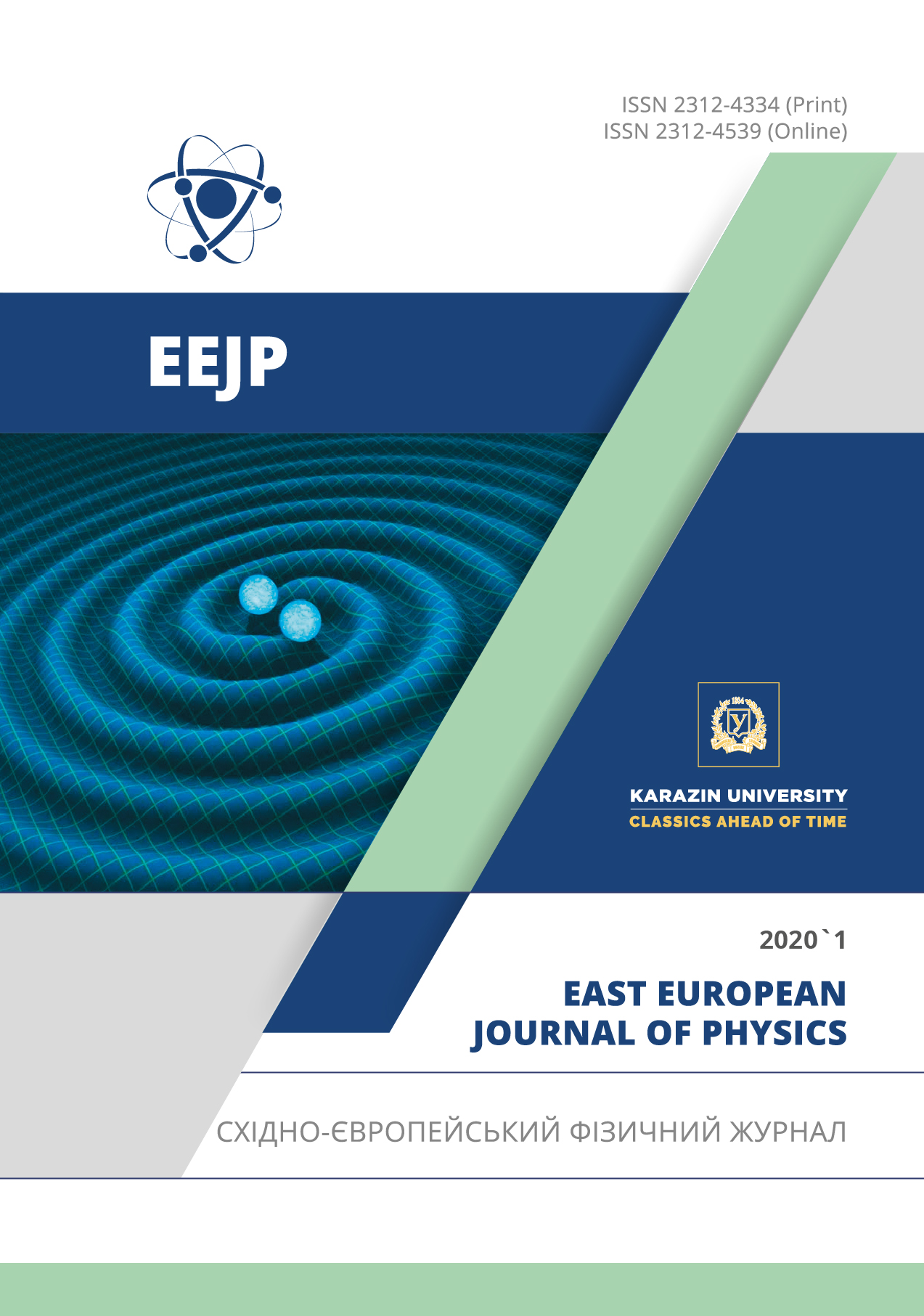Study of Radiation-Chemical Structuring of Compositions Based on Epoxy Oligomers
Abstract
The processes of radiation-chemical structuring of modified epoxy acrylic compositions were studied depending on the nature of epoxy oligomers and modifiers. ED-20 and ED-22 grades epoxy oligomers were chosen as epoxidian oligomers; 3,4-epoxyhexahydrobenzal-3,4-epoxy-1,1-bis(hydroxymethyl)cyclohexane (UP-612 grade), 3,4-epoxycyclohexylmethyl-3,3-epoxycyclohexanecarboxylate (UP-632 grade) were chosen as cycloaliphatic oligomers; diethylene glycol diglycidyl ether (DEG) was chosen as aliphatic oligomer. To modify the epoxy oligomers, unsaturated acrylic monomers, such as acrylic acid and methyl acrylic acid ester; aromatic and aliphatic oligoester acrylates, such as α,ω-methacryl(bis-diethylene glycol)phthalate (MDP-1 grade), α,ω-methacryldi(diethyleneglycolphthalate) (MDP-2 grade), α,ω-methacryl(bis-triethyleneglycol)phthalate (MGP-9 grade) and atri-(oxyethylene)-α,ω-dimethacrylate (TGM-3 grade); condensation product of linseed oil dimerized fatty acids and polyethylenepolyamine, such as oligoamide L-20 grade; condensation product of ricinoleic acid, castor oil and maleic anhydride, such as unsaturated polyester PE-220, were used. The thermophysical and relaxation properties of cross-linked polymers, obtained under exposure to γ-radiation of Co60 and electrons accelerated by the absorbed radiation dose of 50–150 kGy at the beam current of 2‑4 mA and electron energy of 240-300 keV, were studied. The distance from the exhaust window of the accelerator to the irradiated surface of the samples was 63-80 mm. The thermophysical properties of the cured polymers were evaluated using thermomechanical studies on a thermomechanograph with the temperature rise of 1о/min and the pressure of 0.54 MPa in the temperature range of 293‑673 K, as well as the differential thermal and thermogravimetric analyzes on a system derivatograph by L. Paulik, R. Paulik, L. Erdei in the temperature range of 293–973 K with the rise rate of 7о/min. The relaxation properties and molecular mobility of the cross-linked polymers were studied by the dielectric method. The dielectric loss tangent was determined in the temperature range of 143‑393K at the frequency of 1 kHz using a digital automatic bridge of alternating current R-589. The test sample temperature was measured using a potentiometer on a copper-constantan thermocouple, which was placed in the measuring cell along with the test sample. The samples were cooled by placing the cell in a vessel with liquid nitrogen. As a result of the studies, the influence of the chemical nature of epoxy oligomers and unsaturated modifiers on the processes of structure formation and molecular mobility of polymers, obtained under conditions of radiation-chemical curing, was established. It was determined, that when modifying epoxy oligomers with acrylic acid, methyl acrylic acid ester, oligoester acrylates of MGP-9 ((α,ω-methacryl(bis-triethyleneglycol)phthalate)) or TGM-3 ((tri-(oxyethyleneglicol)-α,ω-dimethacrylate)) grades, the structuring of compositions, based on the DEG-1 aliphatic epoxy oligomer and UP-612 cycloaliphatic oligomer, was more efficient than the compositions based on unsaturated ETO oligomers grade such as 2-ethylhexylepoxytallate oligomer and epoxidian oligomers of ED-20 and ED-22 grades. It was established, that the modifier oligoamide of L-20 grade, containing primary and secondary amino groups, increased the radiation sensitivity of the compositions, based on epoxidian and cycloaliphatic oligomers, and reduced the inhibitory effect of atmospheric oxygen. The optimal composition and the main technological parameters were determined, what allowed to obtain materials with high physical and mechanical properties and adhesive strength to various metals. The application of the developed materials under industrial conditions will make it possible to organize a continuous high-speed radiation-chemical process for producing polymer coatings on metals, providing improved working conditions, lower energy consumption, as compared to the thermochemical process of the coatings production, and will increase the corrosion resistance of metals.
Downloads
References
V.I. Irzhak, B.A. Rozenberh, N.S. Enikolopiyan, Сетчатые полимеры [Cross-linked polymers], (Moscow, Nauka, 1979) pp. 250. (in Russian)
A.L. Volynskii and N.F. Bakeev, Surface Phenomena in the Structural and Mechanical Behaviour of Solid Polymers, New York: Taylor & Francis, 2016.
A.I. Vilensky, Radiation-Chemical and Structural Changes in Polymers Irradiated with High-Energy Ions. J. Synch. Investig. 12, 619–622 (2018).
Sh.M. Mammadov and A.A. Garibov, Radiation physics and chemistry of polymers, (LAP Lambert Acad. Publishing, Germany, Saarbrucken, 2015), pp. 668.
E.N. Mochalova, I.V. Lounev, M.F. Galikhanov, I.A. Gabrakhmanov, R.R. Fatikhova, Y.A. Gusev and R.Y. Deberdeev. Study of electret and dielectric properties of epoxiamine polymer materials. Butlerov Communications, 49(1), 91-97 (2017). ROI: jbc-02/17-49-1-91
Simultaneous Thermal Analyzer - STA 449 F5 Jupiter® Method, Technique and Applications, 2015, pp. 16.
M.I. Karyakina, Лабораторный практикум по испытанию лакокрасочных материалов и покрытий [Laboratory workshop for testing paints and coatings], (Khimiya, Moscow, 1979), pp. 240. (in Russian)
Y. Rabek, Экспериментальные методы в химии полимеров [Experimental methods in polymer chemistry], (Mir, Moscow, 1983), pp. 384. (in Russian)
A.P. Belokurova, V.A. Burmistrov, T.A. Aheev, Термомеханический метод исследования полимеров [Thermomechanical method for the study of polymers], (Ivanovo, 2006), pp. 36. (in Russian)
V.M. Sutyahin, A.A. Lyapkov, Физико–химические методы исследования полимеров [Physico-chemical methods for the study of polymers], (Tomsk, 2008), pp. 130. (in Russian).
I.Y. Averko-Antonovich, R. T. Bikmullin, Методы исследования структуры и свойств полимеров [Methods for studying the structure and properties of polymers], (Kazan`, 2002), pp. 604. (in Russian)
Authors who publish with this journal agree to the following terms:
- Authors retain copyright and grant the journal right of first publication with the work simultaneously licensed under a Creative Commons Attribution License that allows others to share the work with an acknowledgment of the work's authorship and initial publication in this journal.
- Authors are able to enter into separate, additional contractual arrangements for the non-exclusive distribution of the journal's published version of the work (e.g., post it to an institutional repository or publish it in a book), with an acknowledgment of its initial publication in this journal.
- Authors are permitted and encouraged to post their work online (e.g., in institutional repositories or on their website) prior to and during the submission process, as it can lead to productive exchanges, as well as earlier and greater citation of published work (See The Effect of Open Access).








